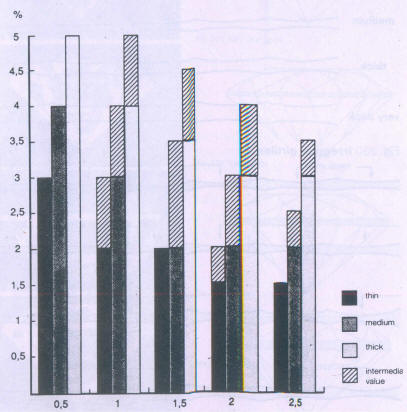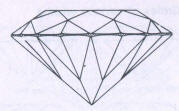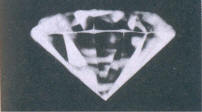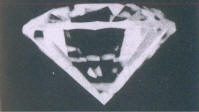- Girdle diameter
- Table diameter
- Table ratio measurement
- Table comparison method
- Total height
- Crown height
- Estimation of crown height - Examination of pavilion facets
- Estimation of crown angle - Estimation of the profile
- Pavilion depth
- Sideways reflection to estimate pavilion depth
- Table reflection to estimate pavilion depth
The girdle is the dividing line between crown and pavilion. Its function is to protect the edge of the stone from damage and fracture. The girdle should be very thin, so that it is just visible to the unaided eye as a light line. A thick girdle can not only adversely affect the color of a cut diamond, but also diminish the light yield and with it reduce the brilliance, as light rays in the region of the girdle width are refracted into the air and not totally reflected (Fig 261. This applies to girdles left in a natural state.ras well as to polished or faceted gird1e, . which only reinforce the perfection of a well "made" stone if it is also thin and even. Completely or partially knife-sharp girdles are dangerous, as they easily fracture during setting of the stone and can thus produce nicks and cleavage cracks (Fig 227).
 |
 |
| Fig 226 The thicker the girdle, the larger the loss of light | Fig 227 Knife-edged girdle with small cleavage cracks. |
As the thickness of the girdle is expressed in percentage of the girdle diameter, it is dependent on the size of the stone, no single size can be given for an ideal girdle.
Corresponding to the size of the stone, the following girdle thicknesses rate as "thin":
Fig 228 Ratio of girdle thickness to stone size

For polished and faceted girdles one per cent more may easily be tolerated as they have a better optical effect than bruted girdles. The girdle thickness is examined by 10 x magnification and graded as:
very thin, thin, medium, thick, very thick (Fig 229-235).
Fig 229 Girdles of various widths
| very thin |
|
| thin |
|
| medium |
|
| thick |
|
| very thick |
|
Fig 230 Irregular girdles
|
|
 |
 |
 |
 |
 |
 |
 |
| Fig 231 Very thin girdle | |
 |
 |
| Fig 232 Thin girdle | |
 |
 |
| Fig 233 Medium girdle | |
 |
 |
| Fig 234 Thick girdle | |
 |
 |
| Fig 235 Very thick girdle | |
Girdles of various widths

Whether a girdle is thin, medium, thick or very thick, the value determined by percentage alone is not decisive; equally important and decisive for grading is the visual impression. It is gained by observation of the wider areas of the girdle at the 16 points of intersection of the main and girdle facets as well as the intervening narrow areas. The proportion measurement of the girdle thickness takes place at the wide places of the intersection points (Fig 236), but in the visual judgment the girdle as a whole, with its narrow and wide areas, is observed and tested (Fig 237). The visual impact is considerably affected by the ratio of the narrow to the wide places. The wide areas may be very extensive, the narrow regions extremely thin; then a wide girdle is measured but visually an impression of a very thin girdle is received. Or the intersection points are almost equally wide as the areas in between; then a thin girdle is measured, whose visual impression as a whole nevertheless gives a medium girdle.
 |
 |
| Fig, 236 The girdle is measured where thickest | Fig 237 The thickness of the girdle is visually evaluated around the whole stone |
Note : Examination of the girdle always comprises the measurement of the proportions, which is done at the wider places, and the visual impression by 10 x magnification, in which the narrow areas and their regularity are examined.
| Estimation of crown angle | Pavilion depth |